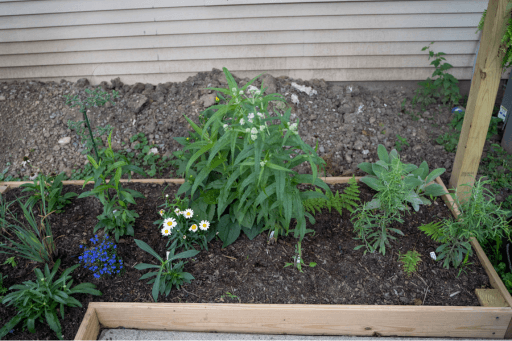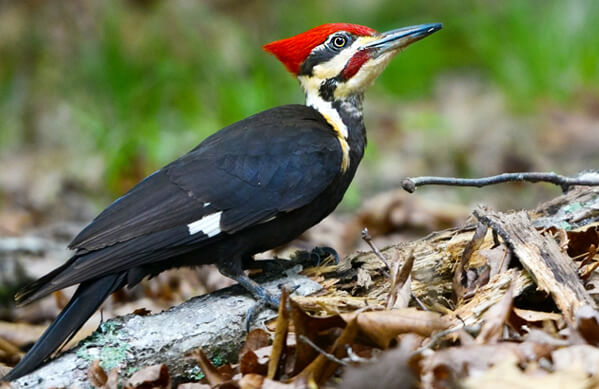ABC Garden Tour: Cutting Down Pesticide Use in a Native Plant-Rich Yard in Ohio

Hear the birds! Sniff the flowers! Drink some lemonade! Summer is in full swing here in Ohio, which means tons of time spent outdoors enjoying nature. Whether in your yard, on your fire escape, in a community garden, or throughout a public park, we humans LOVE tending to plants and digging in the dirt. It is a fantastic way to connect to wildlife and, for American Bird Conservancy (ABC) staff and supporters, bring in some birds!
Plants and birds benefit one another. Apart from their visual appeal, birds can provide pollination and natural pest control (they need to eat), aeration (they need to forage), and fertilization (they need to… well, you get it). Providing different feeding opportunities in the same space (nectar feeders, seed trays, tube feeders, suet cakes, etc.) attracts birds from many different taxa.
As your native plant garden matures, it will become a veritable buffet of natural foods for your feathery neighbors. Earthworms, beetles, caterpillars, and ants are important for insectivores, while leaving some native flowers to go to seed are great food sources for granivores like sparrows and finches. And, lest we not forget, the hummingbirds which may come by to check out your blooms!
(An important aside: As you add native plants to your yard, also consider that you may be luring birds into contact with hazards around your home. Two of the most important things you can do to keep birds safe is to treat your windows to help prevent collisions, and keep cats indoors or contained when outdoors.)
How we plant our gardens and tend to them has a direct impact on the wildlife around us. For birds in particular, the plants and practices we choose cascade throughout their lives. As ABC's Pesticides and Birds Campaign Director, the way humans interact with nature (what we put into it, how it affects wildlife, what we get out of it) is always on my mind. In that spirit, I wanted to “show you around” my garden at home and give some examples of how to keep birds in mind.
Choosing and Sourcing Native Plants

In our yard, my wife and I have chosen to stock a lot of native plant species. The benefit of choosing native plants is that they have evolved to thrive in your neck of the woods (or field, bog, city, etc.), so they are suited to your region's weather, wildlife, and seasons. They are also often less work to maintain in the long run. Most of the plants in our yard are perennial, meaning once we plant them, they will come back every year. If you pick native plants that are adapted to dry areas, they'll need much less water once they're established. And, due to their relationship with a geographic area, native plants are much more resistant to local pests and diseases than non-natives.
To stock our own garden, we found an independent nursery online and brought Shining Aster, Boneset, native Irises, Lady Ferns, and Sweet Everlasting. We bought organically grown species of milkweed and lobelia, along with Black-eyed Susans, from chain hardware stores, and we attempted to grow coneflowers from seed, with mixed results.
To help guide what would thrive in our region, I rely on talking to native plant experts and reading reputable online guides like those from the Xerces Society for Invertebrate Conservation. My neck of the woods falls into the broad categories of temperate deciduous forest and temperate grasslands, so I wanted to find plants which would likely fall there.
Not only do the native plants in our garden require less time and attention, but they attract a much wider variety of birds and insects. One of the most important things about native plants is that many of them are hosts for native insects — meaning that they are also an important source of insect food for birds! I am having a blast identifying the invertebrates that stop by to feed and rest on the native plants.
Make no mistake, native does not mean “plain.” Vibrant yellows, oranges, blues, and purples are all common colors in North American nature, and all are colors that butterflies, moths, ants, birds, and beetles have come to expect. Many native plants also bloom at different times, meaning there is always something on the verge of flowering or leafing — the excitement never stops!
Other Ways We Attract Birds
In addition to choosing native plant species, there are a few other ways we make our yard welcoming to birds. We have a dead pear tree in the back corner of our lot which we decided to (safely) leave standing. The exposed branches provide birds somewhere to perch, evade predators, and hunt for grubs and burrowing insects. A feisty Downy Woodpecker visits most frequently.
We have also hung up bird houses in our trees, much to the delight of a pair of House Wrens which have raised two successful broods in our backyard! Despite the great real estate we provided, some House Finches preferred a hanging basket to any birdhouse.
Pest Control

We have seen our fair share of garden pests come through as well. While we may want to reach for insecticide spray at the first sign of creepy crawlies, I think back to a great conversation ABC hosted with Dr. Aaron Anderson from the Xerces Society. Dr. Anderson talked about reframing how you look at your surroundings and embracing biodiversity. Where I once saw a hodge-podge of desirable and undesirable plants and invertebrates I now see a thriving, diverse ecosystem.
This is not to say that you need to allow your space to become overrun with unwanted plants and insects. Just be thoughtful about the technique you choose, and pick the options with the fewest effects on non-target species when possible. For instance, the Flowering Dogwood I planted was being eaten by something unknown, and while some insect damage is ok and even good (think: insect food for birds!) I was concerned about the tree's survival. So I grabbed some insecticidal soap to spray on the leaves. The spray is only deadly upon contact, does not persist in the environment, and can be washed off of any fruits or vegetables it is applied to. Also, the soap does not negatively impact secondary predators such as birds.
Other small-scale pest control methods make regular appearances in our garden as well. We plant French Marigolds among our tomatoes even though they aren't native, because they attract pollinators and ward off root pests without the use of chemicals. I keep a mealworm feeder near the zucchini and flowers to keep wrens and White-Throated Sparrows as regular visitors and help to cut down on pests such as cucumber beetles. For the grass and weeds in hard-to-hand-pick cracks in pavement, I poured very hot water onto them and waited. The plants died, I plucked them out, and no chemicals were used!
It's Not About Perfection!

While I aspire to eventually turn our yard into some version of native prairie and woodland, we do still enjoy our grass. We have friends over to picnic and our dogs love to run through the short green blades. A sprinkling of compost has replaced any chemical fertilizer, and we leave swaths of clover standing while we mow. We have also moved to mowing only once every two weeks, and only use our trimming and edging tools in high-visibility areas. Even with all of this, there is more I could do.
With every native plant in the ground, there is a little more native habitat for birds. With every reduction in synthetic chemicals, there are fewer toxins put into the environment. With every birdhouse hung and birdbath filled, there is more usable “urbanized” space for wildlife. Making our home wildlife-friendly is an ongoing process, but even still I love to watch the Red-winged Blackbirds, Eastern Bluebirds, House Wrens, and American Crows that call my neighborhood home, all while stopping to smell the (native) flowers.



















































